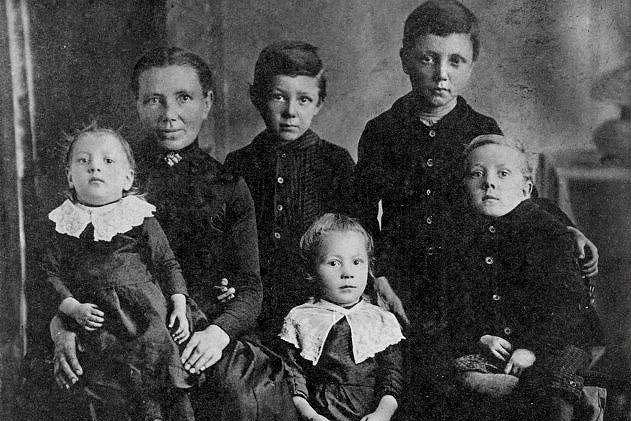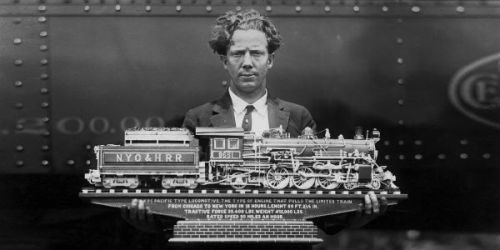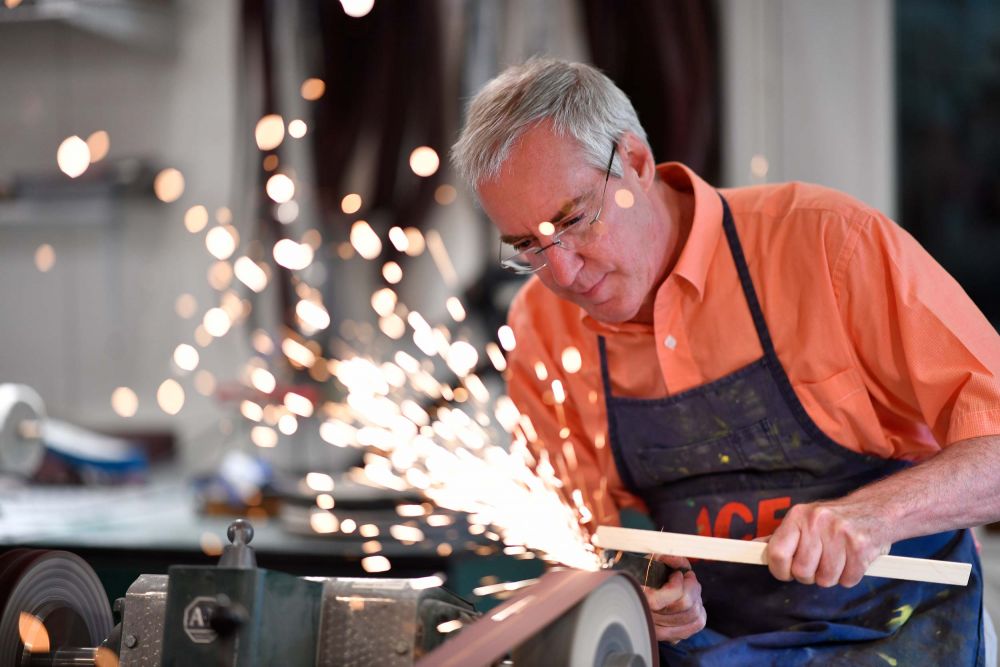Warther Family History

Warther family photo taken in 1890
Ernest "Mooney" Warther (lower right) with his mother Anna and his siblings.
.jpg)
Great Uncle Otto with his pin juggling and punching bag routine circa 1905

Mooney with a locomotive carving on tour with the New York Central Railroad Promotional Exhibit 1923-1926
-1.jpg)
Dad on left, grandpa in center and Uncle Tom on the right. Warther knife shop circa 1950.

Blade grinding in the Dover Ohio pocketknife shop 2019.
Warther Family History
Godfrey and Anna Warther, my great-grandparents, immigrated to Dover, Ohio from Switzerland in 1883. Five years later Godfrey died at the age of 44 leaving Anna with 5 kids under the age of 6, a cow and 20 cents.
Great-Grandma Anna kept the family together and as the children grew they all took on jobs to support the family. The girls worked in the homes and gardens of town folk who paid them and the boys began working full time. When grandpa, Ernest, was 5 years old he tended milk cows and at age 14 he began working full time in a local steel mill.
At age 17 he made his first knife and then his first pocketknife at age 20. In time grandpa became most known for his wood and ivory carvings but his knife making continued to garner attention. He made knives throughout his life and today his pocketknives and WWII commando knives are highly sought after by collectors.
--------
The Warther family has had its share of characters over the generations. Great Uncle Otto was a gymnast and actor. He achieved his greatest fame in the early 1900's as a one man American Vaudeville performer who was able to keep 21 punching bags going actively at the same time.
To achieve this he stood inside a large cage where the bags were arranged so that he was able to hit various one's with his feet, knees, hips , elbows, fists and even his head. Everyone who ever saw the act marveled at it. Otto was so rhythmic and so intent upon keeping all the bags going at top speed that it was comical to watch.
--------
By 1923 grandpa, now known by his nickname Mooney, was recognized for his carving talent and started traveling his detailed carvings of locomotives with major railroad companies nationwide. This lucrative promotional work led him to make pocketknives in the roaring 20's with ivory and pearl handles in this decade of national wealth and abundance.
--------
During the depression grandpa made the pocketknives with ebony handles and when Dad came home from World War II he and grandpa started E. Warther & Son Cutlery. This kitchen knife factory flourishes today in Dover, Ohio. While kitchen knives were the mainstay of the work, dad and grandpa continued to make Warther pocketknives as a specialty item on a regular basis.
-------
My older brother Dale (1952-2010) began making the Warther pocketknife in the 1970's and continued until he passed on in 2010. Dale was the most talented knife maker in our family. He was a true blade smith with a passion for his work and for his family. When Dale died in 2010 I had every hope his talented children would continue the Warther pocketknife heritage. Their lives took them into works of a different nature and they have proven to be hard working and successful young men and women. With nearly a decade of pocketknife silence in our family - I felt it was time to revitalize the knife.
-------
The new Warther pocketknife is offered in 4 different models with each model corresponding to a particular year in the life of the knife when handle materials changed. Handle materials changed over time as grandpa experienced the early formative years (Model 1910), then the roaring 20’s (Model 1923) , the depression 30’s (Model 1938) and then the later years when dad became involved in knife making and very elegant pearl handled knives were made (Model 1963).
These elegant knives hold the same fine lines and handsome design that grandpa developed over 100 years ago. Warther knives have always been made with high carbon tool steel tempered to 58 Rockwell on the C scale. The blade and the back spring are of 1095 tool steel. The bolsters and liners, in keeping with Warther tradition, are of Nickel Silver. The blades and liners have the traditional Warther "spotting" also known as jeweling or engine turning. My pocketknife shop is separate from the Dover, Ohio kitchen knife factory.
The knives are sequentially numbered with the number stamped into the base of the blade along with "Dover Ohio USA". The fine wood display box the knives come in are also of various woods that correspond to the model numbers of each knife.
Sincerely,
David Warther II